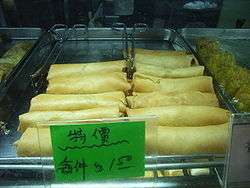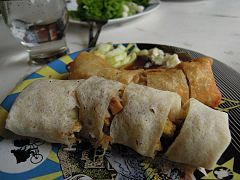Spring roll
Spring rolls are a large variety of filled, rolled appetizers or dim sum found in East Asian, South Asian, Middle Eastern and Southeast Asian cuisine. The name is a literal translation of the Chinese chūn juǎn (春卷 'spring roll'). The kind of wrapper, fillings, and cooking technique used, as well as the name, vary considerably within this large area, depending on the region's culture.
 | |
| Type | Dim sum |
|---|---|
| Course | Hors d'oeuvre |
| Variations | Many |
| Spring roll | |||||||||||
|---|---|---|---|---|---|---|---|---|---|---|---|
| Chinese | 春卷 | ||||||||||
| Hanyu Pinyin | chūn juǎn | ||||||||||
| Cantonese Yale | chēun gyún | ||||||||||
| Literal meaning | Spring roll | ||||||||||
| |||||||||||
Regional history
East Asia
Mainland China
It is believed that spring rolls originated from China. They were a seasonal food consumed during the spring, and started as a pancake filled with the new season's spring vegetables, a welcome change from the preserved foods of the long winter months.[1] In Chinese cuisine, spring rolls are savoury rolls with cabbage and other vegetable fillings inside a thinly wrapped cylindrical pastry. They are usually eaten during the Spring Festival in mainland China, hence the name. Meat varieties, particularly pork, are also popular. Fried spring rolls are generally small and crisp. They can be sweet or savory; the latter are typically prepared with vegetables. They are fully wrapped before being pan-fried or deep-fried.
Non-fried spring rolls are typically bigger and more savory. Unlike fried spring rolls, non-fried spring rolls are typically made by filling the wrapping with pre-cooked ingredients. Traditionally, they are a festive food eaten during the Cold Food Day festival and the Tomb Sweeping Day festival in spring to remember and pay respect to ancestors. The Hakka population sometimes also eat spring rolls on the third day of the third month of the lunar calendar (三月三 sān yuè sān). The wrappings can be a flour-based mix or batter.
Hong Kong and Macau
Spring roll is a fried dish usually available as a dim sum.[2] They typically contain minced pork, shredded carrot, bean sprouts and other vegetables served with Worcestershire sauce.
Taiwan
In Taiwan, the most commonly eaten non-fried spring rolls are popiah, called rùn bǐng (潤餅) in Mandarin or po̍h-piáⁿ (薄餅) in Taiwanese. In northern Taiwan, the ingredients are generally flavored with herbs, stir-fried, and sometimes topped with a finely ground peanut powder before being wrapped. In southern Taiwan, the ingredients are generally boiled or blanched in plain water. Sometimes caster or super fine sugar is added along with the peanut powder before all the ingredients are wrapped.
South Asia
Spring rolls are often eaten as snacks in the Indian sub-continent and are especially eaten during holidays such as Ramadan. In Pakistan, they are usually served with tea along with other assortments of snacks.
Southeast Asia
Indonesia, Malaysia, Myanmar, the Philippines, Thailand, and Singapore


Lumpia is the name for spring rolls in Indonesia[3] and the Philippines, which was derived from Southern Chinese spring rolls. The name lumpia derives from Hokkien lunpia (Chinese: 潤餅; pinyin: rùnbǐng; Pe̍h-ōe-jī: jūn-piáⁿ, lūn-piáⁿ) and was introduced in the Philippine islands during the 7th century.[4] It is a savoury snack made of thin crepe pastry skin enveloping a mixture of savoury fillings, consists of chopped vegetables; carrots, cabbages, green beans, bamboo shoots, banana heart and leeks, or sometimes also minced meat; chicken, shrimp, pork or beef.[5] It is often served as an appetizer or snack, and might be served deep fried or fresh (unfried). In both Malaysia and Singapore, it is called popiah similar as in Taiwan while in Myanmar, it is referred as Kai-yan.[6]
Vietnam
The fried version with minced pork is called imperial rolls or spring rolls chả giò (southern Vietnam), nem cuốn, chả cuốn or Nem rán (northern Vietnam). They are often called "egg rolls" in Western countries, which is a misnomer. Central Vietnam has its own version of a fried roll called Ram. Ram is always made from whole shell-on shrimp or chopped de-shelled shrimp and some green onions, wrapped in rice paper and deep fried. Ram, like most specialty food items from central Vietnam, are not widely available in Vietnamese restaurants overseas.
A Vietnamese imperial roll is different from a Chinese spring roll in that it is typically smaller and contains ground or chopped meats/seafood such as pork, crab, shrimp, chicken, taro or cassava, glass noodles, wood-ear fungi or oyster mushrooms, and shredded carrots. Rice paper is traditionally used as the wrappers. However, there are several Vietnamese restaurants in western countries that may use Chinese spring roll wrappers due to the unavailability of rice paper or ease of use.
Spring rolls or summer rolls are a Vietnamese delicacy known as gỏi cuốn. Depending on region, salad rolls were made differently. Some vegetarian families make vegetarian spring rolls rather than meat spring rolls.[7] However, the typical ingredients include slivers of cooked pork (most often cha pork sausages), shrimp, sometimes chicken or tofu, fresh herbs like basil or cilantro, lettuce, cucumbers, sometimes fresh garlic, chives, rice vermicelli, all wrapped in moistened rice paper. A typical gỏi cuốn may contain boiled pork, boiled rice noodle, cucumber, carrot and herb only. Fresh Vietnamese spring rolls can be made at home or found at Vietnamese restaurants[8][9] and some grocery stores. They are served at room temperature with dipping sauce. Nước chấm, tương xào, or a hoisin peanut sauce are all common dipping sauces. A typical hoisin dipping sauce includes chili, hoisin sauce, peanut butter and sugar. A standard nước mắm pha (nước chấm) dipping sauce is composed of fish sauce, lime, garlic, sugar, and chilies or simply fish sauce, sugar and vinegar.
Oceania
Australia
In Australia, a diverse range of authentic Asian cuisine is available due to immigration, multiculturalism, and the abundant fresh local produce. Both dim sims and Chiko Rolls were inspired by Chinese spring rolls.
Australians also have their own version of a spring roll that can be found in many fish and chip shops in Australia and also bought from a supermarket (Chiko Roll). Rather than using pastry with a rolling technique they have a more doughy texture.
Europe
Germany, France and Poland
In Austria and Germany, deep-fried spring rolls are called Frühlingsrolle, while the Vietnamese salad rolls are called Sommerrolle ("summer roll"). The French call them nem for the fried ones, and rouleaux de printemps for the others, whereas in Poland they are known as sajgonki, named after Saigon, the city from which many of the Vietnamese immigrants in Poland originated.
Netherlands and Belgium
In the Netherlands and Belgium, spring rolls are known as loempia and are deep-fried or sometimes baked. They are thought to have been introduced by immigrants (including Chinese) from Indonesia, a former colony of the Netherlands. Loempias are filled with bean sprouts, chopped omelette, and sliced chicken or crab. It's also getting more common for loempias to appear with sweet and spicy sauce.
Northern Europe
In the Nordic countries, they are known as vårrullar/er (Norwegian/Swedish),[10][11] forårsruller (Danish), or kevätkääryle (Finnish).
Latin America
Argentina
In Argentina, spring rolls are called arrolladitos primavera, and are sold both in supermarkets and Chinese restaurants.
Brazil
In Brazil, spring rolls are called either rolinhos-primavera (IPA: [ʁoˈlĩɲus pɾimɐˈvɛɾɐ]), which is an approximate free translation from English, or as it is called in Japanese restaurants and among people which are used to the plate by the way it came to Brazil from Japanese immigrants, "spring roll" (春巻き, harumaki) (IPA: [haɾɯmaki]). They can be found mostly in Chinese restaurants, usually served with a molho agridoce (sweet and sour sauce) to dip, usually bright red and hot, made with ketchup, vinegar, sugar and sometimes spices such as star anise, which accompanies some other kinds of dishes, and can include onion and sweet pepper. Some Japanese restaurants also serve spring rolls in Brazil, but generally plain or with soy sauce to dip (molho agridoce is also available in some). They are also found in buffet-like fast food restaurants, and can be called either by the Japanese or Brazilian Portuguese name, but most often the latter.
Chile
In Chile, spring rolls are called arrollado primavera, and supermarkets, street vendors and Chinese restaurants sell them. (However, in other countries, "arrollado primavera" refers to a savory pinwheel-type roll made with thin sponge cake and should not be confused with the Chilean version.)
Costa Rica
In Costa Rica, spring rolls are called in Spanish rollito de primavera ("little spring roll"), but is popular known as "Taco Chino" and is offered in almost all the Chinese restaurants as an entree or appetizer.
Mexico
In Mexico, spring rolls are called rollos primavera (which translates directly to "spring rolls"), and are sold in many Chinese restaurants and fast-food establishments accompanied with sweet and sour or soy sauces. On the northwest border with the US, specially in Mexicali, Baja California, the spring rolls are known as chunkun; this name could be related to the Korean chungwon (춘권). They are deep-fried and they are usually served with ketchup topped with a dot of hot mustard as dipping sauce.
Argentina and Uruguay
In Uruguay and Argentina, spring rolls are called arrolladitos primavera (which translates directly to "spring rolls"), and supermarkets and Chinese restaurants sell them. They are common treat carried by catering services and usually served with a small bowl of hot soy sauce to dip them in.
Venezuela
In Venezuela, spring rolls are called lumpia as in the Philippines and Indonesia. All Chinese restaurants sell them, and they are usually served with sweet and sour or soy sauce.
References
- Sri Owen (2014). Sri Owen's Indonesian Food. Pavilion Books. ISBN 9781909815476. Archived from the original on 23 February 2016. Retrieved 16 February 2016.
- yeinjee (23 January 2008). "Maxim's Chinese Restaurant, Hong Kong International Airport". yeinjee.com. Archived from the original on 21 September 2011. Retrieved 13 August 2012.
- Tony Tan. "Indonesian spring rolls (Lumpia)". Gourmet Traveller Australia. Archived from the original on 5 March 2016. Retrieved 25 February 2016.
- "Filipino lumpia gets an American flair". American Food Roots. Retrieved 30 December 2018.
- Amy Besa; Romy Dorotan (2014). Memories of Philippine Kitchens. Abrams. ISBN 9781613128084. Archived from the original on 24 February 2016.
- Suchitthra Vasu (2018). "Popiah". National Library Board, Singapore. Archived from the original on 24 September 2019. Retrieved 16 October 2019.
- Dolinsky, Steve. "Vietnamese spring rolls at Saigon Bistro, 6244 N. California Ave". ABC7 Chicago. Archived from the original on 14 April 2016. Retrieved 4 May 2018.
- Clements, Miles (7 October 2010). "The Find: Dat Thanh in Westminster". Los Angeles Times. Archived from the original on 19 May 2012.
- Jacobson, Max (25 September 1997). "A Real Meal for Under $4? It's True". Los Angeles Times. Archived from the original on 18 May 2012.
- Mat, Allt om. "recept – Allt om Mat". www.alltommat.se. Archived from the original on 4 May 2018. Retrieved 4 May 2018.
- "vårrull". 29 September 2014. Archived from the original on 9 March 2016. Retrieved 4 May 2018 – via Store norske leksikon.
External links

